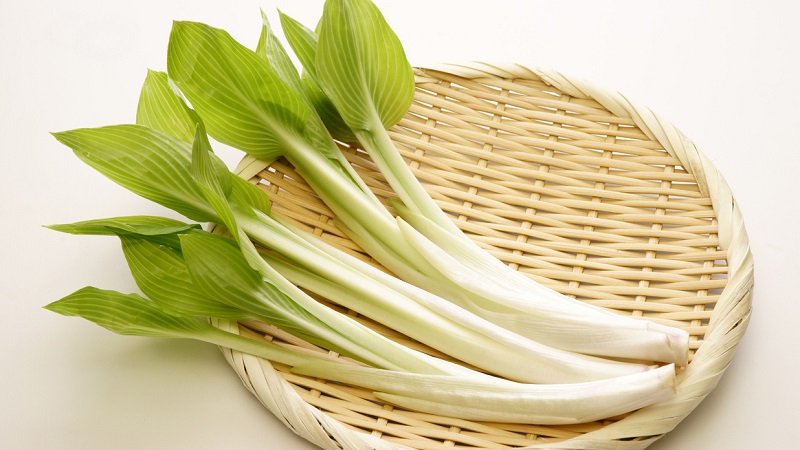Vegetables are an essential part of a healthy diet.
They are packed with nutrients, vitamins, and minerals that are necessary for our bodies to function properly.
While most people are familiar with common vegetables such as carrots, broccoli, and spinach, there are many lesser-known varieties that offer unique flavors and health benefits.
In this article, we will explore vegetables that start with the letter U, along with their nutritional benefits and culinary uses.
Vegetables That Start With U – Ultimate List
Ulluco
Ulluco is a tuber vegetable that is native to the Andean region of South America, particularly Peru and Bolivia.
It is a close relative of the potato and is sometimes referred to as the “Andean potato”.
Ulluco has been cultivated in the Andes for thousands of years and is an important crop for many indigenous communities.
Ulluco comes in a variety of colors, including yellow, green, orange, red, and purple.
The texture of the flesh can vary from firm to soft depending on the variety, and the flavor can range from sweet to slightly tangy.
Ulluco is often compared to the potato in terms of taste and texture, but it has a unique flavor that sets it apart.
In Andean cuisine, ulluco is often used in stews, soups, and stir-fries.
It can also be boiled or roasted and served as a side dish.
Ulluco is high in vitamins C and E, as well as potassium and antioxidants. It is also a good source of dietary fiber and carbohydrates.
One of the interesting things about ulluco is that it contains a natural compound called oxaIic acid, which can cause a tingling or numbing sensation in the mouth when it is consumed raw.
This sensation is similar to the one caused by eating raw spinach or Swiss chard.
To reduce the amount of oxalic acid in ulluco, it is recommended to cook it before consuming.
Upo
Upo, also known as bottle gourd or calabash, is a vine plant that produces a long, cylindrical fruit that is commonly used as a vegetable in many cuisines around the world.
Upo is native to Africa, but it is widely cultivated in Asia, particularly in India, China, and the Philippines.
The upo fruit can grow up to a meter in length and has a light green color.
The flesh is white and has a slightly sweet flavor that is similar to cucumber or zucchini.
The seeds are small and edible, and are often used in dishes like stews and soups.
Upo is a low-calorie vegetable that is high in vitamins A and C, as well as potassium, magnesium, and fiber.
It is also a good source of antioxidants, which can help protect the body against damage from free radicals.
In Asian cuisine, upo is often used in stews, soups, and stir-fries. It is also commonly pickled or made into a type of relish.
In the Philippines, upo is a common ingredient in a dish called “ginisang upo,” which is a stir-fry that also includes ground pork, garlic, onions, and tomatoes.
One of the unique characteristics of upo is its versatility in cooking.
It can be used in both savory and sweet dishes, and the flesh can be cooked until tender or left slightly crunchy for a refreshing texture.
Upo is also known for its ability to absorb flavors from other ingredients in a dish, making it a great addition to soups and stews.
Urad Bean
Urad bean, also known as black gram or black lentil, is a type of legume that is widely cultivated in India, Pakistan, and other parts of South Asia.
Urad beans are small, black, and have a slightly shiny exterior.
They are commonly used in Indian cuisine, particularly in dishes like dal makhani, a popular lentil-based curry.
Urad beans are high in protein, fiber, and carbohydrates, making them a nutritious addition to any diet.
They are also a good source of vitamins and minerals, including iron, potassium, and magnesium.
Urad beans are low in fat and contain no cholesterol, making them a healthy choice for people looking to maintain a balanced diet.
In Indian cuisine, urad beans are used in a variety of dishes, including soups, stews, curries, and snacks.
They can be boiled, fried, or roasted and are often used as a base for dips and spreads.
Urad beans are also used to make papadums, a type of crispy flatbread that is a popular snack in India.
One of the unique characteristics of urad beans is their ability to absorb flavors from other ingredients in a dish.
This makes them a popular choice for curries and stews, where they can absorb the flavors of spices and other ingredients.
Urad beans are also a popular ingredient in Ayurvedic medicine, where they are believed to have a range of health benefits.
They are said to be good for digestion, promote weight loss, and help regulate blood sugar levels.
Ulluco Blanco
Ulluco blanco, also known as ulluco or ulluco tuberosus, is a root vegetable that is native to the Andes region of South America, particularly in Peru and Bolivia.
It is a member of the Oxalidaceae family and is closely related to the more common potato.
Ulluco blanco is typically smaller than a potato and is usually round or oval in shape.
It has a thin, papery skin that can be a pale yellow or green color, and its flesh is white, yellow, or green.
The taste of ulluco blanco is sweet and slightly tangy, with a crunchy texture that is similar to a radish or turnip.
Ulluco blanco is often used in Andean cuisine, where it is typically boiled, baked, or roasted and used as a side dish or in soups and stews.
It can also be grated and used as a garnish for salads and other dishes. Ulluco blanco is high in vitamin C, fiber, and antioxidants, and is also a good source of carbohydrates and potassium.
One of the unique features of ulluco blanco is its ability to change color when exposed to sunlight.
When exposed to sunlight, the skin of the ulluco blanco can turn a darker color, which is due to the production of anthocyanins, a type of pigment that is also found in many other fruits and vegetables.
Ulluco blanco is not widely available outside of South America, but it is becoming more popular as a specialty crop in some areas.
In recent years, there has been growing interest in cultivating ulluco blanco as a sustainable and nutritious crop that can help diversify agriculture and provide economic opportunities for small-scale farmers.
Upland Cress
Upland cress, also known as land cress or American cress, is a leafy green vegetable that is closely related to watercress.
It has a tangy and slightly peppery flavor that is often described as more intense than that of watercress.
Upland cress has small, oval-shaped leaves that grow in a rosette pattern, and its stems are thin and tender.
Upland cress is a cool-season vegetable that grows best in mild climates and can be harvested year-round in some regions.
It is a good source of vitamins A, C, and K, as well as calcium, iron, and potassium.
Upland cress is also rich in antioxidants, which can help protect the body against damage from free radicals.
Upland cress is a versatile vegetable that can be used in many different dishes.
It can be eaten raw in salads, used as a garnish, or added to sandwiches and wraps.
Upland cress can also be cooked and used in soups, stews, and stir-fries, or sautéed as a side dish.
Its tangy flavor makes it a great addition to many dishes, and it pairs well with other leafy greens, seafood, and meats.
Upland cress is easy to grow and can be cultivated in gardens or in containers.
It prefers moist, well-drained soil and partial shade, and can be harvested when the leaves are young and tender.
Upland cress can also be grown hydroponically, which makes it a popular choice for urban farming and indoor gardening.
In addition to its culinary uses, upland cress is also used in traditional medicine to treat a variety of ailments, including coughs, bronchitis, and digestive issues.
It is said to have anti-inflammatory and detoxifying properties and is sometimes used as a natural remedy for skin conditions and other health issues.

Urui
Urui is a leafy green vegetable that is native to South America, particularly in the Amazon basin.
It is also known by several other names, including calaloo, jute mallow, and Jew’s mallow.
Urui belongs to the Corchorus genus and is related to other leafy greens such as okra and spinach.
Urui leaves are elongated and have a pointed tip and can grow up to 6 inches in length.
They are a rich green color and have a slightly fuzzy texture. The taste of urui is similar to spinach, with a slightly bitter flavor that becomes milder when cooked.
Urui leaves are high in vitamins A and C, as well as calcium and iron.
Urui is a popular ingredient in South American and African cuisine, where it is typically used in soups, stews, and sauces.
In Brazil, it is often cooked with seafood and coconut milk to make a traditional dish called “moqueca”.
In Ghana and Nigeria, it is used to make a soup called “ewedu,” which is usually served with a type of dough called “amala”.
Urui is also valued for its medicinal properties, particularly for its ability to promote healthy digestion and reduce inflammation.
It is believed to have antibacterial and anti-inflammatory properties and is sometimes used as a natural remedy for sore throats, coughs, and other respiratory ailments.
Urui is relatively easy to grow and can be cultivated in warm, humid climates.
It prefers well-drained soil and plenty of sunlight and can be propagated from seeds or cuttings.
Urui is a fast-growing plant and can be harvested within a few weeks of planting. It is also a hardy plant and can withstand periods of drought or flooding.
Urad Dal
Urad dal, also known as black gram or black lentil, is a type of pulse that is commonly used in Indian cuisine.
It is a small, black, and oval-shaped lentil with a white interior.
Urad dal is a rich source of protein, dietary fiber, and a variety of vitamins and minerals.
Urad dal is widely used in Indian cooking and is the main ingredient in popular dishes such as dal makhani, dal tadka, and idli.
The dal is typically soaked overnight and then cooked with a variety of spices and seasonings to create a thick and flavorful stew or soup.
It is often served with rice, roti, or naan bread.
In addition to its culinary uses, urad dal is also valued for its nutritional properties. It is high in iron, potassium, calcium, magnesium, and vitamin B.
The fiber in urad dal helps to promote healthy digestion and can lower cholesterol levels. It is also a good source of protein for vegetarians and vegans.
In traditional Ayurvedic medicine, urad dal is believed to have a variety of health benefits.
It is used to improve digestion, boost energy levels, and promote overall health and wellness.
It is also believed to be a natural diuretic and can help to reduce inflammation in the body.
Urad dal is relatively easy to prepare and can be cooked in a variety of ways.
It can be boiled, roasted, or ground into flour to make a variety of dishes.
It is also available in canned or dried form in many grocery stores and specialty markets.
If you are interested in trying urad dal, there are many recipes and resources available online to help you get started.
Other Vegetables that Start with U
While the vegetables listed above are some of the most well-known vegetables that start with the letter U, there are several others that are worth mentioning. Here are a few more vegetables that start with U:
Ulam Raja
Ulluco Rojo
Umbrella Plant
Urad Sabut
Urad Chilka
Urena
Urad Dhuli
Unripe Papaya
Urugua
Ulluco Amarillo
Urad Mogar
Conclusion
Vegetables are an essential part of a healthy diet, and it’s important to incorporate a variety of different vegetables into your meals.
While some vegetables are more well-known than others, there are many lesser-known varieties that offer unique flavors and health benefits.
The vegetables listed above that start with the letter U are just a few examples of the many delicious and nutritious vegetables that are available.
Whether you’re looking to try something new or simply want to add more variety to your diet, there are plenty of vegetables to choose from.
Read also: Vegetables That Start With S / Vegetables That Start with T



